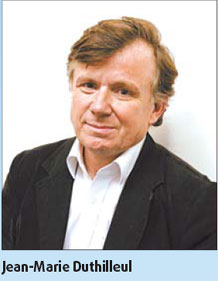Penchant for things Chinoise
Fascinated by China's vast history and culture, French architects have long used Chinese elements such as the quadrangle layout, red bricks and bronze in their designs.
Jean-Marie Duthilleul, president and architectural engineer at AREP, is among French building designers who have a penchant for things Chinoise.
"China's booming construction sector spurs our success," he said. "My inspiration in design for China's buildings dates back to my university days. I was enchanted by Chinese philosophy."
While Chinese philosophy inspires his designs, modern buildings should be grounded in traditional culture, Duthilleul said after he won a series of top design awards for his landmark buildings in China, such as the Western Ring Square (Xihuanguangchang) and the Capital Museum in Beijing, as well as the Wuhan and the south Shanghai railway station.

The Chinese philosophy of two sides of conflict inspired Duthilleul in a museum design generated from the relationship between man and nature, of "heaven and earth, yin and yang, the void and solid, and the changeable and fixed", he said.
"I had a lot of inspiration for the museum, but I think my focus was primarily on China's traditional culture and on modern ways to translate it," Duthilleul once said when talking about the design of the Capital Museum in Beijing.
Duthilleul borrowed the eaves from the hutong courtyard houses and gave them an avant-garde look in the museum. The combination of traditional and modern Chinese culture makes the museum an example of fundamental Chinese urban architecture blended with a newfound contemporary character.
The design of the museum assumes that although Beijingers live in the midst of modernity, all Chinese retain in their memory, conscious or unconscious, a specific perception of space. "A museum needs spacious rooms to interest visitors in abstract exhibitions," he pointed out.
Within its large rectangular space, the museum comprises three characteristic elements whose volume, indoor space and material specifically relate to their symbolic and functional use.
Duthilleul's understanding of three-dimensional space when designing the museum comes from the Taoist ideal that "Tao produces one, one gives birth to two, two gives birth to three and three gives birth to everything in the world".
The museum covers a total area of 60,000 sq m and with three main spaces protected by a large, rectangular horizontal covering standing back from Fuxingmenwai avenue, a major thoroughfare running east to west, to create a public square that opens out onto the city, showcases the building and creates a court where festivals and cultural events can be held.
The Capital Museum of Beijing turns around being a Chinese palace where the massive roof towers above three core volumes united around a squared courtyard. They have inspired themselves from Beijing traditional materials for those three main volumes; namely, bricks, wood and bronze.
First, the bricks part recalls an ancient wall fence from a Chinese palace in which one can find all the restoration section in it. Secondly, the wood element evokes a traditional Chinese chest that contains Beijing's history division. At last bronze Material used in Beijing's Capital Museum reminds a Chinese vase as it is outlined with a cylinder shape. That very last part located in the northwest wing shelters all private exhibitions in this public building. Moreover, this latter stands out from the front faade and from the roof as a precious archaeological shrine that rises from earth.
Furthermore the squared courtyard remains the key link between those different volumes; when the three main materials bricks, wood and bronze give an out of time dimension to this museum with a fine combination between a modern architecture and traditional materials from Beijing.
(China Daily 10/24/2008 page42)














